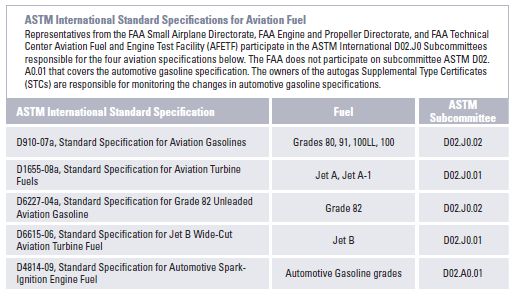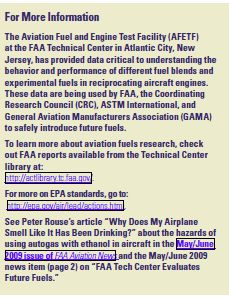Fuel-ish Questions Fuel-ish Answers
Mark S. Orr
Reprinted with permission from FAA Aviation News
Just a glance at the EAA AirVenture® grounds in Oshkosh remind us that airplanes come in an amazing range of shapes and sizes. However they may differ in appearance, all powered aircraft share a need for fuel. Given the growing buzz about availability of fuels for reciprocating aircraft engines, here are a few answers to some “fuel-ish” questions.
Is My Fuel Certified?
FAA does not certify aviation fuel, but the agency has a role: FAA certifies use of the fuel in engines and aircraft. Specifically, FAA’s Aircraft Certification Service administers safety regulations for type certification of engines and aircraft. As part of the type certification, standard specifications control the fuel(s) used to show compliance to the regulations. For certificated engines and aircraft, FAA considers the fuel specification an operational limitation. Steve Thompson’s Airworthiness 101 article in the May/June issue of the FAA Aviation News explained the type certification process and described the type certificate data sheet (TCDS). The TCDS, engine installation manual, aircraft flight manual, and aircraft placards all list approved fuels. It is the responsibility of aircraft operators to use only those fuels.
Like many other countries, the United States uses ASTM International (www.astm.org) specifications for aviation fuel. ASTM International is a consensus standards organization comprised of producers, users, and general interest groups that develop, issue, and maintain these fuel specifications and test methods.
Why Are Aviation Fuels Different?
The first aircraft used spark ignition piston engines burning the automotive gasoline that was available at the time. Over the years, as aircraft engine designs evolved to produce more power with less weight, fuels evolved with them. Operational and research experience in the early part of the 20th century identified fuel parameters that affect engine and aircraft performance, such as density, energy content, vapor pressure, and knock performance. The first fuel specifications captured this experience and ensured more consistent performance. The industry developed the octane scale that indicates how resistant the fuel is to premature detonation, or knock, in the engine. Octane is the factor most associated with engine power and it became the fuel grade.
What Drives Availability of Fuels?
Demand. In the 1930s and 1940s, the military was a primary user of aviation gasoline. The large radial engines used in military aircraft at the time drove the introduction of fuel grades with higher octane. With the introduction of turbine engines in the 1950s, the military and commercial airline focus shifted to jet fuel. Consequently, the need for many of the grades of aviation gasoline decreased. Today, there are only four grades (80, 91, 100LL, and 100) listed in ASTM International Standard Specification D910. Market forces determine the grades produced. The predominant U.S. commercial aviation fuel for reciprocating engines is 100LL avgas.
Cost. Aviation fuel use and production is a fraction of the use and production of diesel, home heating, and automotive fuels, which affects the availability and cost of aviation fuels. For example, 100LL avgas represents less than 0.5 percent of the total gasoline produced in the United States and, because of its lead content, 100LL is produced, delivered, and stored separately from its unleaded automotive gasoline counterpart. This contributes to the higher cost of avgas compared with automotive gasoline.
Environmental Concerns. The primary environmental concern for avgas is lead emissions. Though tetraethyl lead (TEL) has not been in automotive gasoline since the late 1970s, it remains an additive in aviation gasoline to boost octane for safety reasons. Introducing grade 100LL did reduce the added TEL amount, but FAA and industry have searched for an unleaded replacement for many years. So far, no one has found a “drop-in replacement fuel” that will cover all applications in the existing fleet. For example, though ethanol has been proposed, it is not a “drop-in.” Among other issues, engine and aircraft performance tests have shown significantly reduced aircraft range that may not be acceptable for all operations.
Introducing New Fuels
In the United States, the path to introducing a new fuel goes through ASTM International, the engine and aircraft type design holders, and FAA. Introducing a new fuel requires testing of fuel properties, components, engines, and aircraft and a thorough technical and safety review of any issues. Approaches to introduce new fuels include:
- Existing standard specification. An example of this approach is adding different grades of avgas to ASTM International Standard Specification D910. The grades in D910 differ only in the tetraethyl lead quantity added to produce the needed octane and the dye used to differentiate among the grades. Historically, higher octane grades allowed for higher-power engines. Once fuels are included in the specification, those seeking design approvals for engines and aircraft can use those fuels to show compliance with certification regulations.
- New fuel specification to replace an existing fuel. This approach introduced Grade 82UL aviation gasoline. The 82UL standard specification provides an aviation quality gasoline using available gasoline stocks that can be used in engines and aircraft with an auto gas Supplemental Type Certificate (STC). FAA issued Special Airworthiness Information Bulletin (SAIB) CE-00-19 (https://www.faa.gov/regulations_policies) to communicate approval of 82UL as an alternative fuel for certain automotive gasoline STCs.
- New fuel specification for a new fuel. In the early 20th century, this approach produced the first specifications for aviation gasoline and then later for jet fuel. Currently, ASTM is working to introduce new unleaded avgas specifications keeping D910 as the leaded avgas specification. Once the new specification is approved and released, those seeking design approval for engines and aircraft can use fuel that meets this specification to show compliance with certification regulations.
- Hybrid approach. This approach is currently the path used for alternate jet fuels, allowing the introduction of new synthetic turbine fuels. A new specification will list the performance properties of new fuels as blended with Jet A/A-1 and allow designation of the blend as a D1655 fuel. Each new fuel would be a blend component with detailed requirements listed in individual annexes to the main specification. This approach will allow control of parameters unique to the new fuel and separate from Jet A/A-1.

What’s the Future for Aviation Fuels?
While we cannot predict the future for aviation fuels, FAA is an active participant with the industry as this future unfolds. Here’s how.
Research. The Aviation Fuel and Engine Test Facility (AFETF) at the FAA Technical Center in Atlantic City, New Jersey, have conducted research on aviation gasoline for many years. The Center has performed full-scale engine testing and laboratory analyses to evaluate:
- The interaction of advanced fuel chemical components and additives with existing fuels and with each other
- The performance and properties of alternative and experimental fuels, such as ethanol and biofuels
- The octane performance of unleaded avgas
Standard Specifications. As the primary aviation fuel standards organization in the U.S., ASTM International has been active in the aviation fuel arena. Currently, task forces are working on:
- Developing new standard specifications for unleaded avgas
- Introducing 87 and 91 grades into the 82UL • standard specification (D6227)
- Developing an aviation grade ethanol standard specification
- Introducing synthetic turbine fuels into D1655
- Preparing for the future introduction of bio derived jet fuels
Avgas Lead Emissions. FAA’s Office of Environment and Energy is working closely with the Environmental Protection Agency (EPA) to evaluate the impact of lead emissions from aircraft engines on the environment. EPA recently issued a new standard for lead emissions in the National Ambient Air Quality Standard (NAAQS). This new standard will require a coordinated response from the aviation industry. FAA is already working with groups, such as the General Aviation Manufacturers Association (GAMA), Aircraft Owners and Pilots Association (AOPA), Experimental Aircraft Association (EAA), the Coordinating Research Council (CRC), and ASTM International to address future fuels for the reciprocating engine fleet.
While we cannot predict the future for aviation fuels, we can be certain that market forces, environmental concerns, and availability issues will drive changes. We can also be certain that FAA will be an active participant in meeting the challenges ahead.
Mark S. Orr is an aviation safety engineer in the FAA Small Airplane Directorate’s Programs and Procedures Branch. Dave Atwood from the Aviation Fuel and Engine Test Facility (AFETF) at the FAA Technical Center in Atlantic City, New Jersey, and Mark Rumizen from the FAA Engine and Propeller Directorate contributed to this article.

|